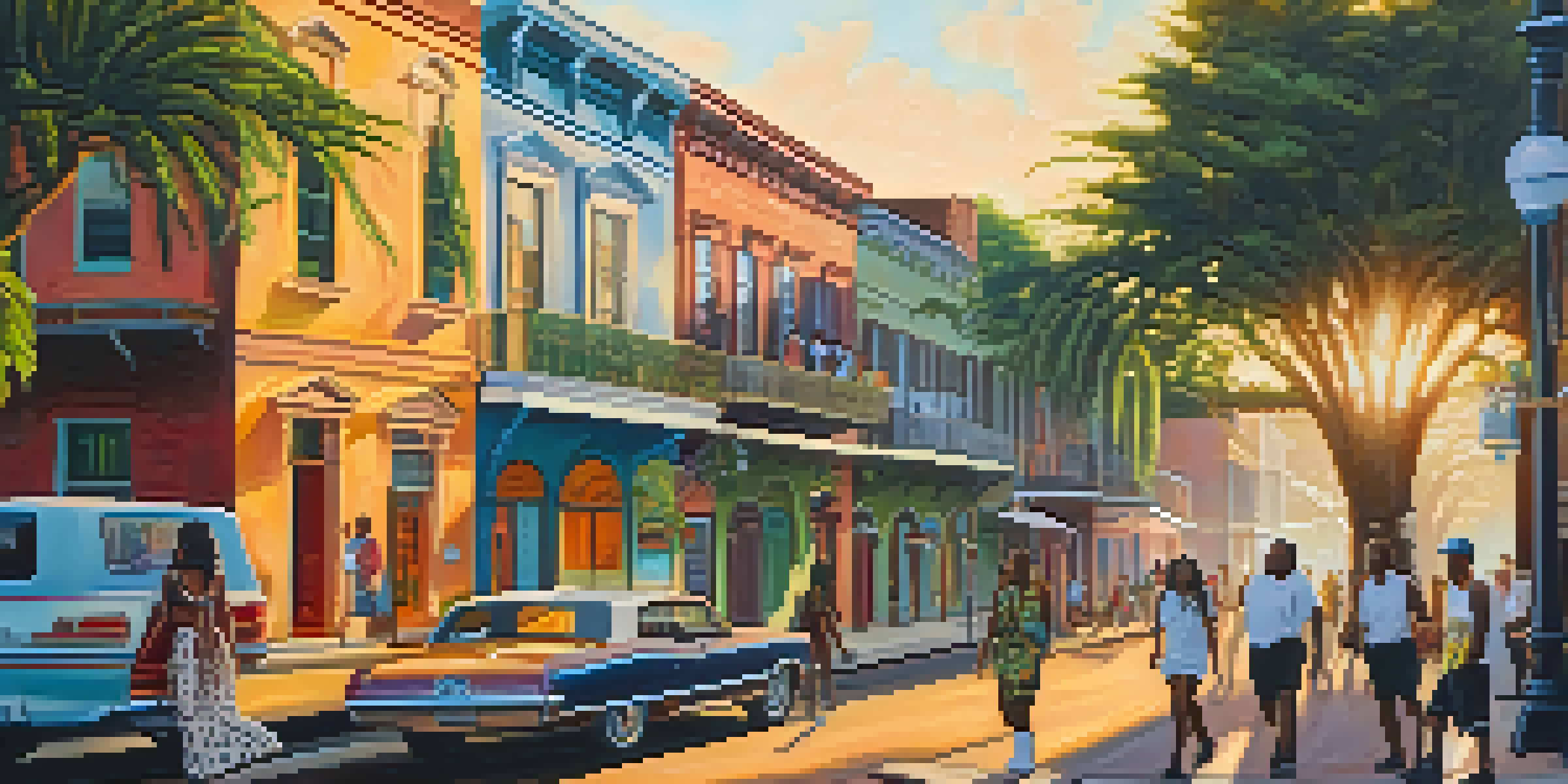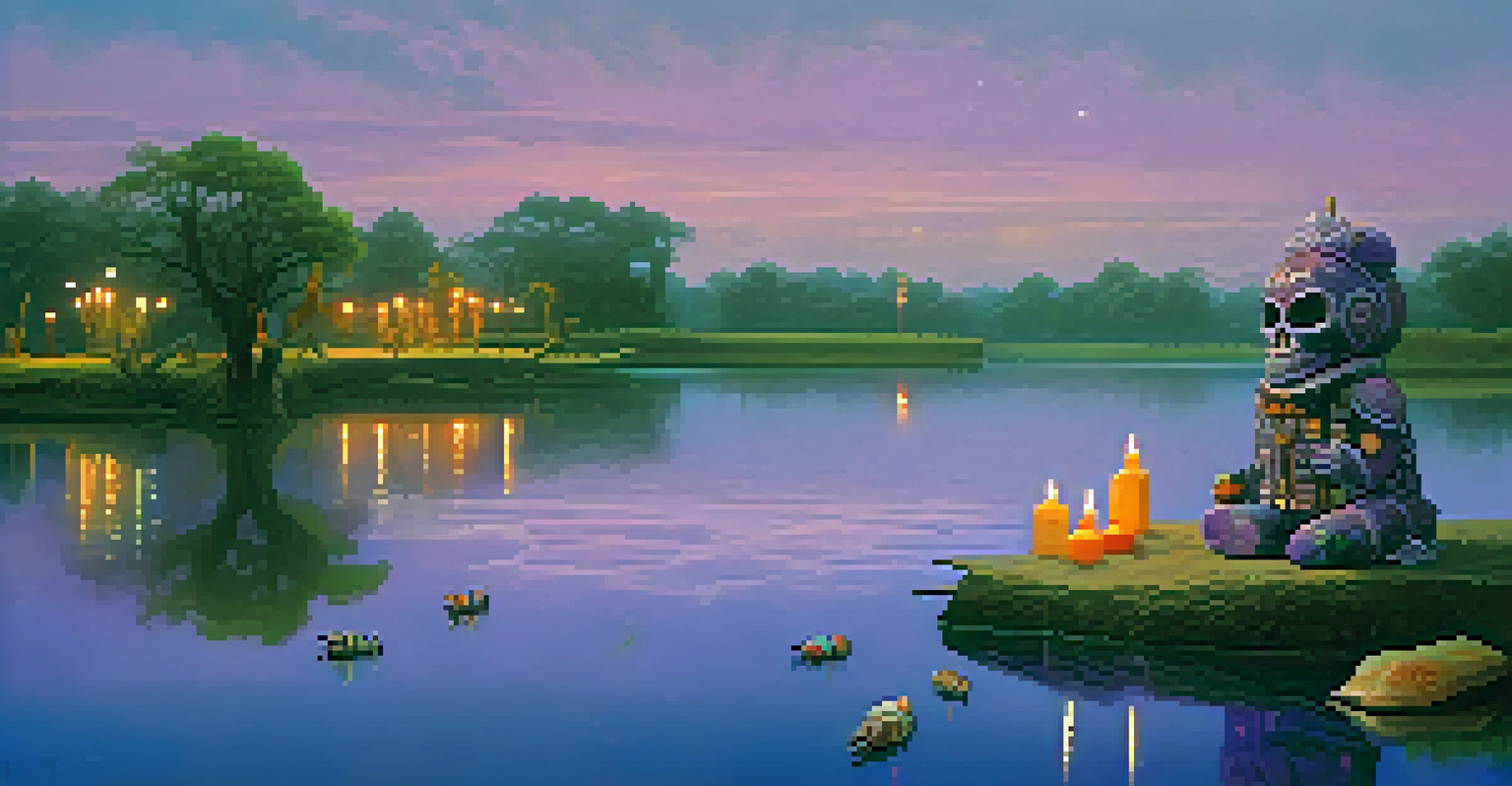The Role of Voodoo in New Orleans Literature and Art

The Historical Context of Voodoo in New Orleans
Voodoo, a spiritual tradition originating from West Africa, found its way to New Orleans through enslaved Africans. This rich cultural blend formed a unique practice that combined elements of African religions, Catholicism, and Native American spirituality. Over time, Voodoo became intertwined with the city's identity, influencing not just religious practices but also the arts and literature. Understanding this historical backdrop is essential to appreciating its role in the creative expressions of the region.
Voodoo is a term that has been sensationalized and misunderstood; it is a rich tradition that embodies resilience and spirituality.
New Orleans' vibrant history, marked by colonialism and migration, created a fertile ground for Voodoo to thrive. The city’s diverse population contributed to a melting pot of ideas that shaped various artistic and literary movements. Writers and artists began to explore Voodoo not just as a religion but as a symbol of resistance and cultural resilience. This exploration opened up new avenues for storytelling and artistic expression, often reflecting the complexities of identity and spirituality.
Additionally, figures like Marie Laveau, the renowned Voodoo priestess, became cultural icons, serving as both inspiration and subject for countless works. Her legacy exemplifies how Voodoo has transcended its historical roots to become a powerful narrative in New Orleans’ artistic heritage. This blending of history and spirituality creates a rich tapestry that continues to captivate artists and writers alike.
Voodoo as a Theme in New Orleans Literature
In literature, Voodoo is often portrayed as a mystical and alluring force, inviting readers into a world rich with symbolism and intrigue. Authors like Zora Neale Hurston and Anne Rice have drawn upon Voodoo themes to explore deeper human experiences, such as love, loss, and the quest for identity. These narratives often serve to demystify Voodoo, providing a more nuanced understanding rather than the sensationalized portrayals commonly found in popular culture.

Moreover, contemporary writers like Jesmyn Ward and Tom Piazza have integrated Voodoo elements into their storytelling, reflecting the ongoing cultural significance of the practice. Their works often highlight the intersection of personal and collective histories, showcasing how Voodoo serves as a connection to ancestral roots. This literary exploration allows readers to engage with the complexities of the human experience through the lens of Voodoo spirituality.
Voodoo's Rich Historical Roots
Voodoo in New Orleans is a unique blend of African traditions, Catholicism, and Native American spirituality that reflects the city's diverse cultural identity.
Through these literary depictions, Voodoo becomes a metaphor for resilience and empowerment, illustrating how individuals navigate their lives amidst societal challenges. The characters often embody the struggles and triumphs of the New Orleans community, making Voodoo not just a backdrop but a vital force driving the narrative. This thematic richness invites readers to reflect on their own connections to culture and tradition.
Artistic Expressions of Voodoo in New Orleans
The influence of Voodoo on visual art in New Orleans is both profound and diverse. Artists such as George Rodrigue have incorporated Voodoo symbols and themes into their work, creating pieces that resonate with the city's cultural fabric. Rodrigue's famous Blue Dog series, while not exclusively about Voodoo, often reflects the spirit of the city, encapsulating the mystical essence of New Orleans.
Art is a reflection of culture, and in New Orleans, Voodoo serves as a vibrant thread that weaves through our artistic expressions.
Moreover, the vibrant street art scene in New Orleans frequently features Voodoo imagery, showcasing its cultural significance in a contemporary context. Murals and graffiti often celebrate Voodoo figures and motifs, connecting the past with the present. This public art movement invites locals and tourists alike to engage with the city’s spiritual heritage, fostering a sense of community and shared identity.
Additionally, artists like the late sculptor and painter, John Scott, used Voodoo as a source of inspiration to address social issues and historical injustices. His works often blended spirituality with activism, demonstrating how Voodoo can serve as a tool for expression and change. This relationship between Voodoo and visual art highlights the enduring power of spirituality in shaping artistic narratives within New Orleans.
The Role of Voodoo in Music and Performance Art
New Orleans is renowned for its rich musical heritage, much of which is infused with Voodoo themes and influences. Genres like jazz and blues often incorporate elements of Voodoo spirituality, reflecting the city’s cultural tapestry. Musicians such as Dr. John and Billie Holiday have woven Voodoo motifs into their lyrics, creating a sound that resonates with both the sacred and the secular.
Performance art also plays a significant role in expressing Voodoo traditions, with events like the annual Voodoo Festival celebrating the intersection of music and spirituality. These performances often showcase a fusion of various art forms, highlighting the communal aspect of Voodoo practices. By engaging audiences in this way, artists create an immersive experience that resonates with the spiritual essence of New Orleans.
Voodoo in Literature and Art
Contemporary writers and artists are using Voodoo themes to explore identity and resilience, enriching the cultural narrative of New Orleans.
Furthermore, the rhythms and chants associated with Voodoo rituals have influenced musicians across genres, creating a dialogue between tradition and modernity. This blend of past and present allows for an ongoing exploration of identity and cultural heritage. As a result, Voodoo continues to inspire new generations of artists, ensuring that its legacy remains vibrant and relevant.
Cinematic Representations of Voodoo
Film has often depicted Voodoo in ways that both reflect and distort its true nature. Classic films like "The Skeleton Key" and "Angel Heart" use Voodoo as a backdrop for suspenseful storytelling, often emphasizing the exotic and mysterious. While these cinematic portrayals can be entertaining, they often miss the cultural significance and depth of Voodoo practices in New Orleans.
Conversely, documentaries and films by local filmmakers strive to present a more authentic representation of Voodoo culture. Works like "Voodoo: The Secret of the Loa" aim to educate audiences about the realities of Voodoo, challenging stereotypes and misconceptions. By providing insights into the practices and beliefs of practitioners, these films foster a deeper understanding and appreciation of the tradition.
In this way, cinema becomes a powerful tool for both perpetuating myths and promoting education about Voodoo. As filmmakers navigate this complex landscape, they can either reinforce stereotypes or contribute to a richer narrative. This duality highlights the importance of responsible storytelling in representing Voodoo and its cultural significance.
Cultural Festivals Celebrating Voodoo
Cultural festivals in New Orleans serve as vibrant showcases of the city’s diverse heritage, with Voodoo taking center stage in many of these celebrations. The Voodoo Music + Arts Experience, for instance, blends musical performances with spiritual rituals, creating a unique atmosphere that honors the tradition. Attendees can immerse themselves in a celebration of art, music, and spirituality, fostering a deeper connection to the culture.
Moreover, these festivals often feature local artisans who create and sell Voodoo-inspired crafts, further promoting awareness and appreciation of the tradition. From handmade dolls to ritualistic items, these crafts embody the essence of Voodoo, allowing attendees to take a piece of the culture home with them. This connection through art helps to preserve and share the rich history of Voodoo.
Cultural Festivals and Voodoo
Festivals like the Voodoo Music + Arts Experience celebrate the tradition, blending art, music, and spirituality while promoting cultural awareness.
By participating in these festivals, both locals and visitors can engage with the spiritual aspects of Voodoo while enjoying the artistic expressions surrounding it. This blend of celebration and education emphasizes the importance of preserving cultural traditions in a modern context. As Voodoo continues to evolve, these festivals play a crucial role in keeping its spirit alive.
The Future of Voodoo in New Orleans Art and Literature
As New Orleans continues to evolve, so too does the role of Voodoo in its art and literature. Contemporary artists and writers are increasingly exploring Voodoo themes through innovative lenses, reflecting the shifting dynamics of culture and identity. This ongoing exploration ensures that Voodoo remains relevant, adapting to the contemporary landscape while honoring its roots.
Emerging voices in the creative community are often redefining how Voodoo is represented, challenging stereotypes and offering fresh perspectives. By incorporating personal narratives and modern experiences, these artists and writers are making Voodoo more accessible and relatable. This shift not only enriches the cultural dialogue but also invites a broader audience to engage with Voodoo’s complexities.

Ultimately, the future of Voodoo in New Orleans art and literature is bright, filled with potential for growth and transformation. As new generations of creative minds embrace and reinterpret these traditions, Voodoo will continue to serve as a source of inspiration and connection. This enduring legacy highlights the importance of cultural preservation and the power of storytelling in keeping traditions alive.